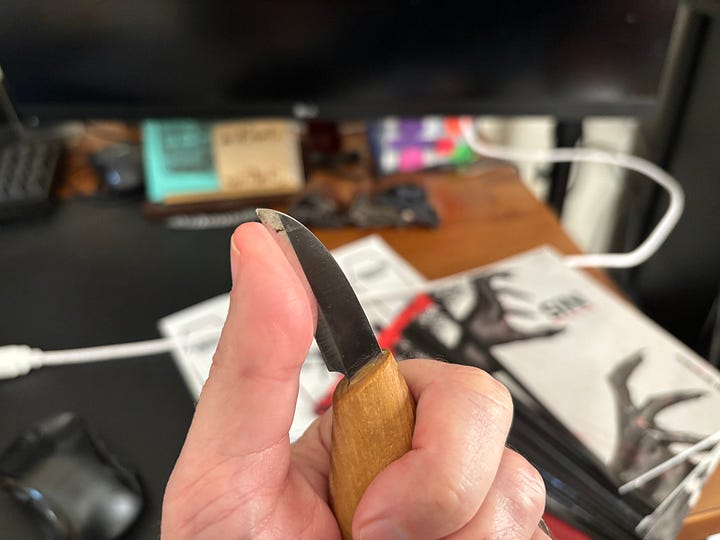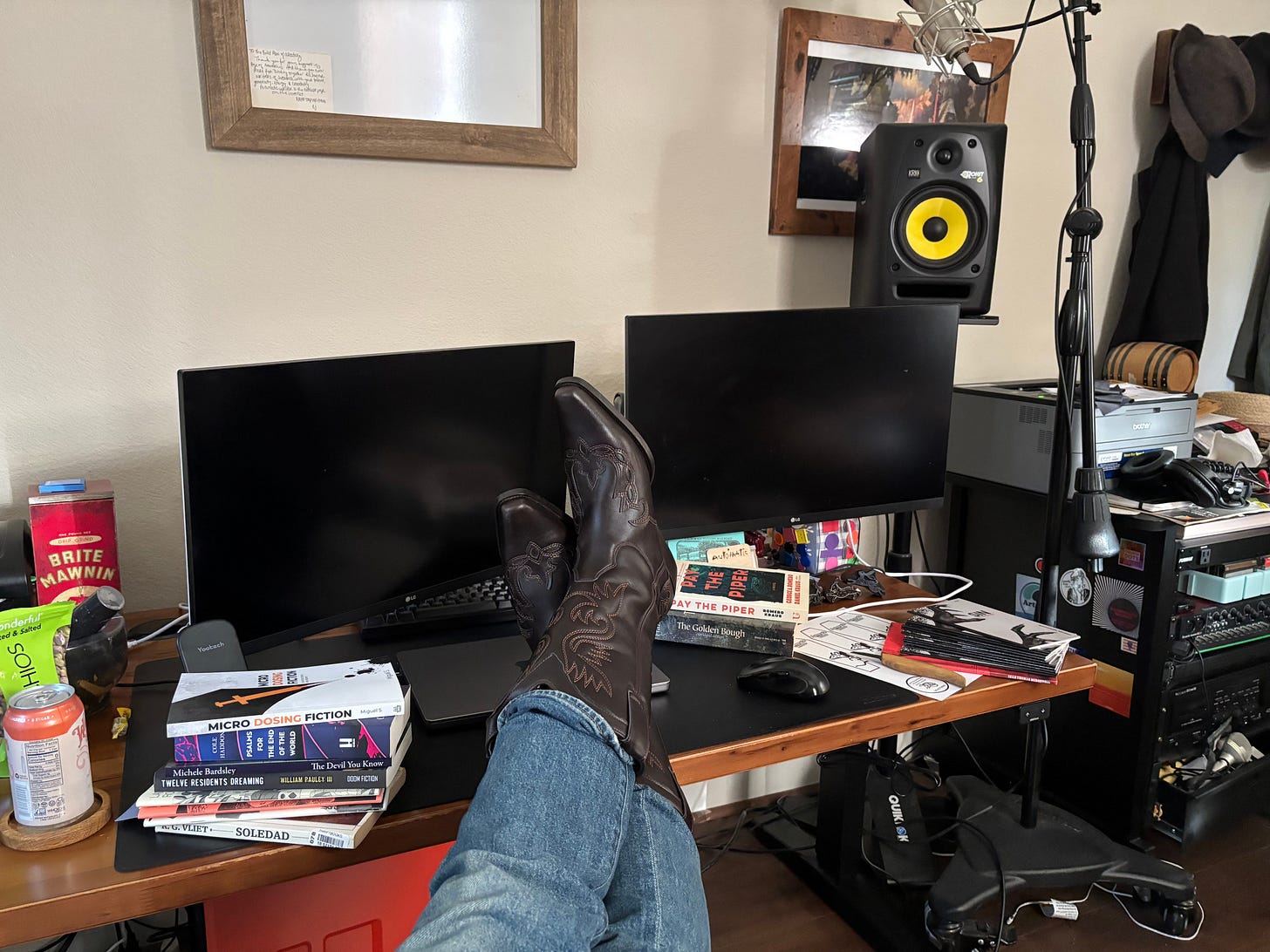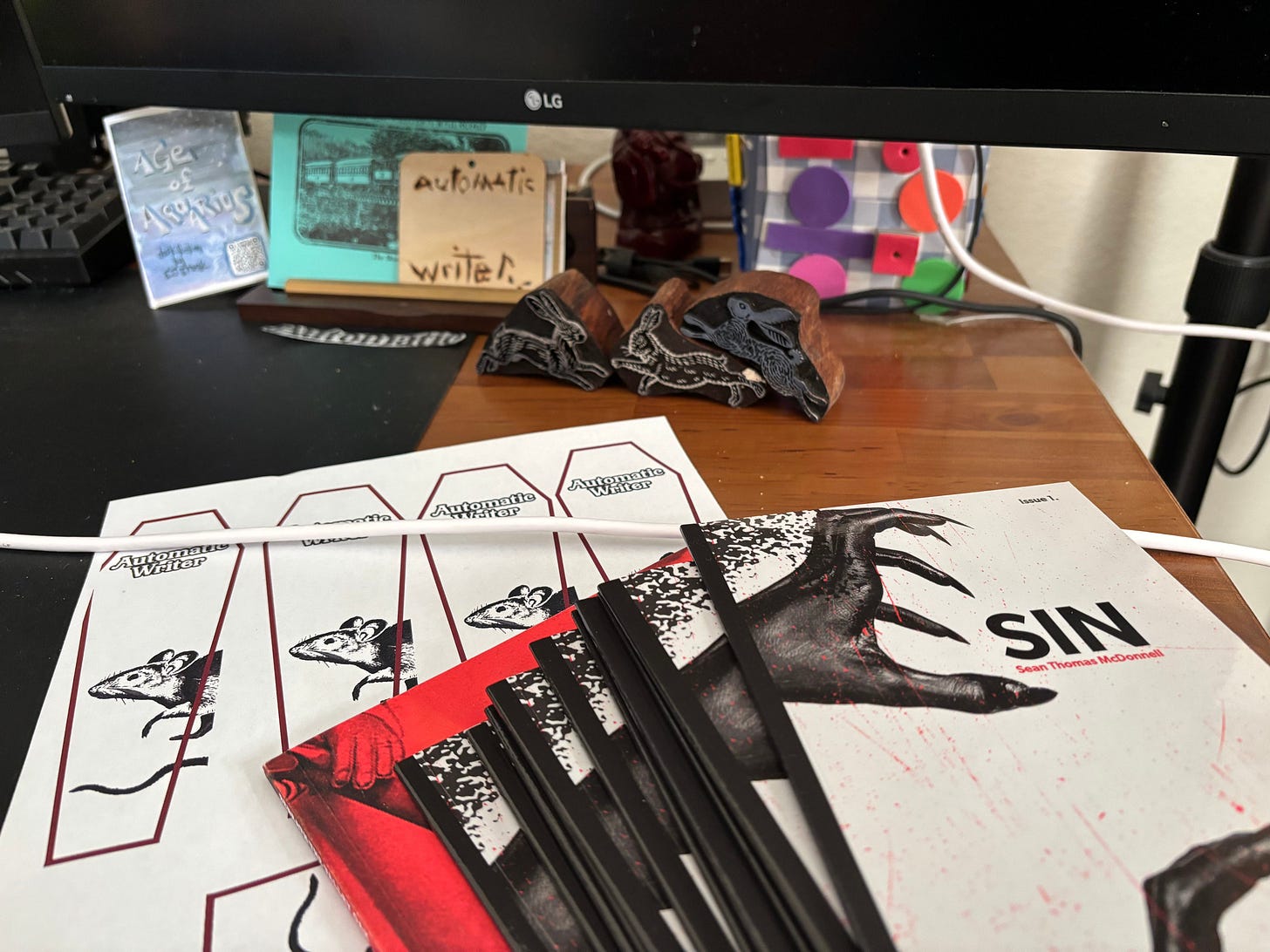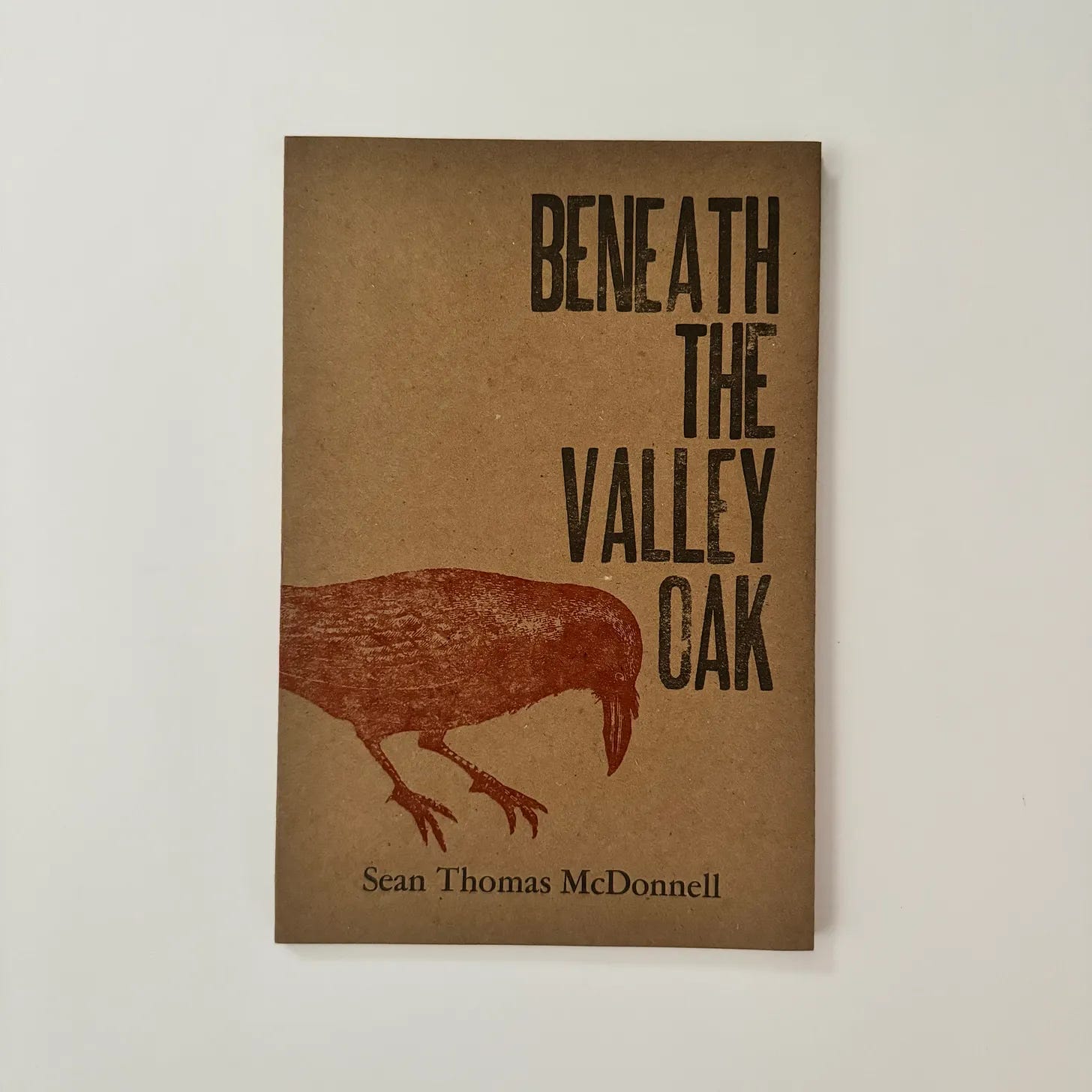Writing with Demons: Sean Thomas McDonnell's Creative Process
Meet the speculative fiction writer who lets his demons do the typing
Welcome to Methods—the series where we explore the creative habits of fellow Substack writers.
This week, we are featuring Sean Thomas McDonnell, a horror and speculative fiction writer whose journey from punk rock musician to storyteller offers a fascinating glimpse into the creative process.
His substack, Automatic Writer, brings a fresh voice to the horror genre, blending his musical background with a knack for dark storytelling.
In this interview, Sean shares his disciplined approach to daily writing, his unorthodox workspace habits, and how his past as a songwriter influences his current creative process.
Enjoy!
Know someone with a unique creative process? Drop their name in the comments—I’d love to feature them!
Building a Daily Writing Practice
Before I begin, I’ll preface by stating that I’m not pushing for anyone to work as I do. Everyone should explore and find a process that works well for them! For me, a writing routine is crucial. Without a daily block of time dedicated to writing, I’m not sure I’d ever get anything done. I wake up every morning at 6:50 AM, make coffee, and get to work.1
There is no word count requirement.
The only goal is to get something—anything—onto the page. If I walk away having written one sentence, great. The win is in the effort. I write for roughly 2 hours. While most of my writing is done in those early hours of the day, I’ll often write for another 30 min to an hour each night, but whether I do this or not is based on my appetite; if a story is cookin’, it’s hard to keep me away, but if it’s a grind, I’m not exactly champing at the bit.
The Morning Ritual: Coffee First, Words Second
The only ritual I have before I start writing is
killing a virginmy morning cup of coffee.2 I’m fully present while taking that first sip. It’s the best. I’ve never done a writing warmup, and honestly, they sound miserable to me. I’d rather drown in a sea of unclear thoughts and malformed sentences.
A Peek Inside Sean’s Workspace
I’ve spent a lot of time perfecting my workflow as a musician, but as a writer, I don’t have any rigid way of working. I’m always trying to figure out how to get what’s in my head onto the page, so I’ll give various apps and tools a go, but most apps and tools are nothing but distractions. I’m someone who likes to research while I write, so I have multiple monitors for efficiency.
I do respect the minimalist. I wish I were a minimalist! But. Well. I’m not.3
I have a brass pen, but my handwriting is terrible, so it’s mostly for show. I run my thumb over the blade of a woodcarving knife while I think. I have a whiteboard that I’ll occasionally put writerly things on. But the moment I put a goal of some kind up on it, I know I’ll never reach that particular goal. Maybe I should write things on the board that I DON’T want to happen! Like, “Get cancer by July!” or “Lose your job by noon!”
Writing in the Substack Era
I’ll use Scrivener here and there, but most of the time, I write my short stories directly into the Substack app like a gd modern-day cowboy. Yeehaw!
I sometimes use AdobeExpress for my story art, but the app only shows me repulsive AI art now. It’s probably good because it’s forced me to start making more of my own art and working with other artists.
Influences and Inspirations
Influences…hmm…well…I’ve been having an existential crisis since 96, so that’s one thing.
Growing up, my parents were avid readers, unlike me—I didn’t read at all—but my parents always had a book in their hand. They’d read while us kids watched The Simpsons or played “guns” outside. I had every type of plastic gun you could think of—even had plastic grenades! Pew Pew Pew. USA USA USA. Eventually, I decided I liked books over grenades.
All this to say, my parents were readers and now I’m a reader. Donna Tartt made me want to write. I wanted to tell a story like The Goldfinch or The Secret History, but shortly after beginning my writing journey, I discovered a proclivity for horror and surrealism. So Tartt got me to my desk, but Stephen King and Gogol kept my pen moving.4
Daniel Kraus is a significant influence on me. His book Whalefall doesn’t fit in any set genre, and I really like that. The story is good, the writing phenomenal, the premise is ridiculous—and it works! He has a lot of hot takes about writing rules, and I like that. Blow up all rules.5
As for themes, I grew up in a Southern Baptist Church, and my father was the head deacon. There will always be an undercurrent of religion and duality within my stories. Now that I’m older, I don’t believe in God, but please don’t tell Him because I do believe in Hell.


Nature, Horror, and Creative Sparks
Other authors inspire me. Whether it’s terrible fiction, mediocre fiction, or great fiction, I’m here for it. 1. “Oh, I can write better than that!” 2. “This would be better if…” 3. “Shit, I need to level up.” Nature!6 If you’re looking for horror, go out on a hike. Nature holds everything that makes horror wonderful: Beauty, violence, gore, ancient whispers…err…psithurism. I’ve found several stories out on the trails. One time, I saw yellow jackets eating a dead mouse. Horror. <3
The Role of Community and Feedback
When I first got serious with my writing, I joined the Walnut Creek Writers Guild. Their feedback helped me develop a solid foundation. Before joining that group, I didn’t even know how to structure dialogue. That was only a little over a year ago.7
Most of my peer feedback now comes from fellow horror and weird fiction writers on Substack. I’m not the first person to say this, but the only guaranteed method for writing a story is to sit down and write the story. Sometimes it’s easy, a lot of times it’s hard work. Embracing the ‘process over product’ mindset was a game changer. As long as I show up and do the work, I’m exactly where I need to be.
And if you think about it, every dream about becoming a professional author depends on your ability to write good stories. So focus on that. Learn, grow, and have a good time.
All of my fiction is done through automatic writing. A demon named Junie takes over when I write stories. A different demon named Jacques takes over when I need to compose emails. I think they’re married.
Evolution of Creative Process
My process has been consistent for about a year, leading to substantial growth (in my ability to tell the story I want to tell).
I’d be lying if I said I don’t think about my subscribers or growing my readership, but if I like something I’ve written and other people aren’t that into it, I can dismiss negative opinions or low engagement fairly easily.
But if I’m not sure how I feel about a story, then low engagement or unsubscribes can impact my mental health. So it’s important that I feel confident.
Superstitions and Creative Rules
In my late teens, there were calamities, so I became convinced I was severely unlucky. I decided to lean into superstition; when I saw a ladder, I’d walk beneath it. If I found a penny, I’d only take it if it were tails up. I’d spill salt on the table and throw a pinch over my right shoulder. I’d break a mirror and then break two more. I’d open my umbrella indoors!!! Thirteen was my number. Daddy-O.
“What’s your problem?” they’d say.
“Whatcha got,” I’d reply.My vegan leather jacket read, “Hells Devils”. Across my right hand, etched into my knuckles in indigo, WRIT. And on my left hand (*dead-eyed into the camera like Robert Mitchum) is the word, GOOD.
When I sit down to writ good, I must do the following, or it’s extremely bad luck: Sit down, turn on my computer, and start typing. If I don’t do this, forget it. I might as well give up.
Creative Tools and Techniques
To enhance my vision of a particular project, sometimes I’ll attempt to sketch a scene from the story I’m writing. I typically use a Kindle Scribe. If I’m writing a period piece or something with a very specific theme, creating a playlist can heighten the mood for me.
A few books I can recommend are Bird by Bird by Anne Lamott, On Writing by Stephen King8, and The Elements of Style by Strunk & White. (If you’re a drinker, have a glass of wine while you read this one out loud in a sassy voice. It’s fun.) When I write Westerns, I wear cowboy boots. When I write Noir, I wear a fedora. When I write as a woman, I wear a dress. When I write Non-fiction, I write in the nude. When I write as a monster, I wear a smile.
Thanks, Sean!
Check out Sean’s collection of short stories:
Beneath The Valley Oak by Sean Thomas McDonnell - Second Edition
Subscribe to Writers Are Weird
Access the full archiveDocumenting the creative process. Written by Sam Mas
While Sean is an early bird writer, our research across Methods interviews shows varied writing rhythms: 45% prefer morning writing, 35% are night owls, and 20% maintain flexible schedules. Like Sean, 60% of interviewed writers maintain a daily practice.
Coffee appears to be the writer's beverage of choice, with 40% of interviewed writers citing it as their primary writing companion. Tea drinkers make up 30%, while the remaining 30% have no specific beverage preference.
Hemingway Wrote His Best Books in a Messy, Cluttered Bedroom
While Sean embraces his non-minimalist tendencies, he's in good company. Ernest Hemingway, despite his famously sparse prose, wrote some of his most celebrated works in a chaotic bedroom in Key West. His workspace was filled with books, papers, and various objects that inspired his writing—proving that creative spaces don't need to follow conventional wisdom about organization.
Reading as a Writer: Why the Act of Writing Changes How You Read
Sean's journey from non-reader to writer mirrors a common transformation in the literary world. When writers begin to actively engage with literature, they often develop what Vladimir Nabokov called a 'double perception'—simultaneously experiencing a story as both reader and writer. This shift fundamentally changes how they interact with texts, moving from passive consumption to active analysis of craft and technique.
Building Stories & Foregoing Rules: Stephen Duffy's Writing Process
Like Sean's approach to horror and genre-bending, other writers have found success in breaking conventional writing rules. Fellow substack horror writer
Sean's use of nature for inspiration aligns with a broader trend - 65% of writers we've interviewed report that nature walks and exercise boost their creativity. Nature serves as both a source of ideas and a way to maintain creative energy.
Toni Morrison On What Makes A Good Editor
The evolution of a writer often involves learning to balance external feedback with creative intuition. From writing groups to editorial relationships, developing confidence in one's work while remaining open to constructive criticism is a delicate balance that many successful writers, like Sean, have learned to master.
Overcoming Fear as a Writer: Lessons from Stephen King
Stephen King's influence on modern writers extends beyond his fiction. His practical approach to the craft, as detailed in 'On Writing,' has helped countless authors overcome their creative anxieties. King's emphasis on showing up daily to write, regardless of inspiration, mirrors Sean's disciplined morning routine.








What a fun interview! It's always cool to read about others and their processes.
brother from another mother. 😎